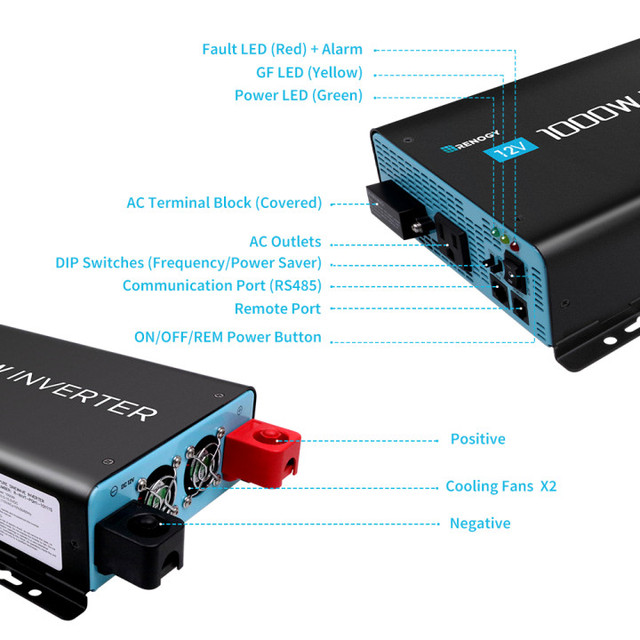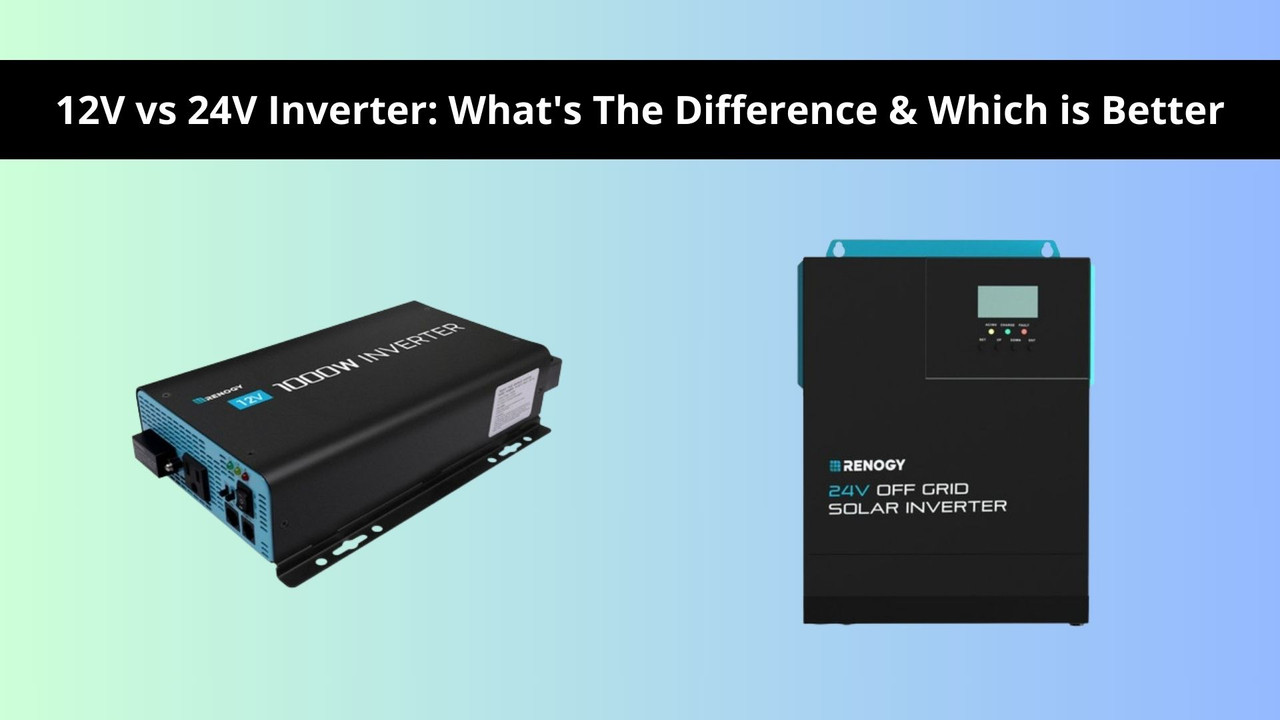12V vs 24V Inverter: What's The Difference & Which is Better
Inverters play a crucial role in modern power systems, converting DC (direct current) to AC (alternating current) for use in everyday devices. When choosing between a 12 voltage inverter and a 24 volt inverter, understanding their differences is essential for optimal performance. These devices, which emerged in the mid-20th century, have become increasingly important with the rise of renewable energy and mobile power needs. The choice between 12V and 24V systems affects efficiency, power output, and compatibility with various appliances. This article will explore the pros and cons of 12 voltage inverters vs 24 voltage inverters, considering factors such as energy loss, battery requirements, and suitability for different applications like solar setups, RVs, or emergency power solutions.
How Does an Inverter Work
An inverter is a crucial device in modern power systems, designed to convert direct current (DC) electricity into alternating current (AC) electricity. This conversion is essential because many renewable energy sources, such as solar panels and batteries, produce DC power, while most household appliances and the electrical grid operate on AC power. Inverters bridge this gap, allowing us to use clean energy sources to power our everyday devices and connect to the grid.

The process of how an inverter works is both fascinating and complex. At its core, an inverter uses electronic circuitry to rapidly switch the direction of the DC input, creating an AC output. This is achieved through a series of steps:
- Input Stage: The inverter receives DC power from a source like batteries or solar panels.
- Switching: High-speed electronic switches, typically transistors or MOSFETs, rapidly turn the DC current on and off.
- Waveform Generation: This switching creates a square wave alternating current.
- Filtering: The square wave is then passed through filters to smooth it into a sine wave, which is the standard form of AC power used in homes and businesses.
- Transformation: A transformer may be used to step up the voltage to the desired output level, typically 120V or 240V for household use.
- Output Stage: The final AC power is delivered, ready for use by standard electrical devices.
Modern inverters often employ advanced techniques like pulse-width modulation (PWM) to create a more efficient and cleaner sine wave output. They also include safety features such as overload protection, short circuit prevention, and temperature control to ensure reliable operation.
Understanding how inverters work is key to appreciating their role in renewable energy systems, off-grid setups, and backup power solutions. As technology advances, inverters continue to become more efficient, compact, and capable of handling a wider range of power needs, making them an indispensable component in our transition to cleaner, more flexible energy systems.
12V vs 24V Inverter: The Differences and Which One Is Better
When diving into the world of off-grid power systems, RV setups, or backup power solutions, one of the crucial decisions you'll face is choosing between a 12 voltage inverter and a 24 volt inverter. This choice can significantly impact the efficiency, performance, and overall functionality of your power system. To make an informed decision, it's essential to understand the key differences between these two voltage options and how they affect your specific needs.
Inverter Efficiency: A Crucial Element
Inverter efficiency is a crucial factor when choosing between 12 voltage inverters and 24 volt inverters. This efficiency determines how effectively DC power is converted to AC, impacting overall system performance and operating costs. 12 voltage inverters, while common in smaller setups, face efficiency challenges due to higher current requirements, which lead to greater energy loss through heat and voltage drop. In contrast, 24V inverters often boast higher efficiency, especially in larger systems, thanks to lower current needs and reduced wire losses. This improved efficiency can result in energy savings, extended battery life, and potentially smaller system components. However, the choice between 12V and 24V isn't always straightforward. Factors such as load size, inverter quality, and specific power needs all play a role. While 24V systems generally offer better efficiency for larger installations, 12V systems may still be suitable for smaller, low-power applications.
Battery Banks Comparison: 12V and 24V
12V systems offer simplicity and wider compatibility with off-the-shelf components, making them ideal for smaller setups like RVs or basic off-grid cabins. They generally have lower initial costs but may face efficiency challenges in larger installations. In contrast, 24V battery banks excel in efficiency and scalability, particularly for high-power demands and future expansions. They require less current, resulting in reduced heat generation and energy loss through wiring. While 24V batteries may be more expensive individually, the overall system cost can be lower due to reduced wiring and potentially fewer components. 24V systems also typically perform better in high-drain situations and charge more efficiently when paired with renewable sources.
For example, a 2400W inverter system would require 200A at 12V, but only 100A at 24V, significantly reducing wire size and cost. This difference becomes even more pronounced in larger systems, highlighting the efficiency advantages of 24V setups. Ultimately, the choice depends on your specific power needs, budget, and long-term plans for your energy system.
12V vs 24V Inverter Cost
When comparing 12 voltage inverters vs 24 volt inverters, cost considerations extend beyond the initial purchase price. While 12V inverters often have lower upfront costs, making them attractive for smaller setups, 24V systems can be more cost-effective in the long run, especially for larger installations. The higher efficiency of 24V inverters typically results in lower energy losses and reduced operating costs over time. Additionally, 24V systems generally require thinner, less expensive wiring due to lower current needs. However, 24V batteries and some components may be pricier initially. For high-power applications, the cost difference narrows as 24V systems become more economical. Factors like system size, power requirements, and potential future expansions should guide your decision. Ultimately, while 12V systems may save money upfront for small applications, 24V systems often provide better value for larger or growing power needs due to improved efficiency and scalability.
How to Choose the right Inverter for Your Solar System
When choosing an inverter for your solar system, consider 12V for small setups, 24V for medium-sized systems, and 48 voltage inverter for large installations. Higher voltages offer better efficiency and lower installation costs. Selecting the right inverter voltage is crucial for optimizing your solar system's performance and cost-effectiveness.
Key Factors to Consider
- System Size and Energy Needs: Match the inverter voltage to your system's scale and power requirements. A 12V inverter is suitable for small, off-grid applications like RVs and boats. A 24V inverter is ideal for medium-sized systems, while a 48V inverter is best for large residential or commercial installations with higher energy demands.
- Cost and Installation: Higher voltage systems require thinner cables, reducing installation costs. Although the initial cost of a 48V inverter might be higher, the savings on cable and installation expenses can offset this.
- System Efficiency: Higher voltages improve efficiency by reducing energy loss. A 48V inverter offers the highest efficiency, ensuring your solar system operates at peak performance, providing reliable and sustainable energy.
How Can I Maintain Inverter: Key Tips
Proper maintenance of your inverter is essential to ensure your solar system operates efficiently and lasts for years. Here are some key tips to keep your inverter in top condition:
Key Tips for Maintaining Your Inverter
- Regular Inspections: Conduct visual inspections regularly to check for wear, damage, or loose connections. Look for corrosion, dirt, or debris.
- Clean the Inverter: Keep the inverter clean and free from dust and debris. Use a soft, dry cloth and avoid water or cleaning agents.
- Check the Ventilation: Ensure the inverter is well-ventilated and not obstructed. Proper airflow prevents overheating.
- Monitor Performance: Regularly monitor performance through the display or software. Look for error messages or performance drops.
- Avoid Overloading: Ensure the inverter is not overloaded by adhering to its capacity and manufacturer’s recommendations.
Where do I buy the best 12V inverter
Finding the best 12V inverter for your solar system can enhance performance and reliability. Renogy is a top choice in the solar industry, known for producing efficient and reliable products. The Renogy 1000W 12V Pure Sine Wave Inverter is highly recommended for its robust features and dependable performance.

This inverter delivers clean, consistent power with pure sine wave technology, making it ideal for sensitive electronics. It converts 12V DC to 120V AC with high efficiency and minimal energy loss. It also includes overload, overheat, and short-circuit protection for enhanced safety and durability, and operates quietly, suitable for various applications.
You can purchase Renogy inverters directly from their official website for authentic products and full warranty coverage. Whether you are a novice or an expert, there are products suitable for you to choose from, covering various scenarios such as cars, portable solar systems, emergency power supplies, off-grid homes, etc.
Conclusion
Choosing between a 12V and 24V inverter for your solar system involves understanding their unique benefits and applications. Originally, 12V inverters were popular for small-scale setups like RVs and boats due to their simplicity and lower costs. However, as solar technology advanced, 24V inverters emerged as a more efficient solution for medium-sized systems, offering reduced energy loss and better performance. Today, the choice between 12V and 24V depends on factors such as system size, installation costs, and efficiency goals. By considering these aspects, you can select the optimal inverter to maximize the performance and sustainability of your solar energy setup.
Frequently Asked Questions
1. Can I use a 12V inverter with a 24V battery?
No, you cannot directly use a 12V inverter with a 24V battery. Inverters are designed to match the voltage of the battery they are connected to. Using mismatched voltages can damage the inverter and
2. Is 12V to 24V more efficient than 120V to 24V?
Yes, converting from 12V to 24V is generally more efficient than converting from 120V to 24V. Lower voltage conversions incur less energy loss due to lower current flow. This efficiency makes 12V to 24V converters advantageous for certain applications like solar systems and mobile setups.
3. How many batteries can be connected to the 24V inverter?
The number of batteries you can connect to a 24V inverter depends on the amp-hour (Ah) capacity of the batteries and the inverter's power rating. Typically, for a 24V system, batteries are connected in series to achieve the desired voltage. The total capacity should match or exceed the power requirements of your inverter and appliances. Consult the manufacturer's specifications for maximum battery bank size and ensure proper wiring and configuration for optimal performance and safety.
4. Is 12v to 24v more efficient than 120 to 24?
Yes, converting from 12V to 24V is generally more efficient than converting from 120V to 24V. Lower voltage conversions typically result in less energy loss due to lower current flow. This efficiency advantage makes 12V to 24V converters preferable in many applications, such as solar systems and mobile setups, where minimizing energy loss is crucial for optimizing overall system performance and longevity.











